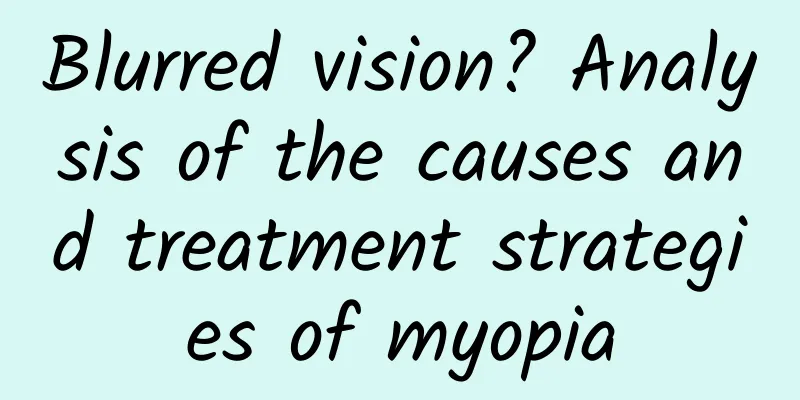Blurred vision? Analysis of the causes and treatment strategies of myopia

|
Author: Fang Ye Nan Children's Hospital Affiliated to Fudan University Reviewer: Yang Chenhao, Chief Physician, Children's Hospital Affiliated to Fudan University Myopia, which often manifests as blurry distant objects and relatively clear nearby objects, affects hundreds of millions of people worldwide and is particularly common among adolescents and school-age children. Understanding the causes, effects, and prevention and control of myopia is crucial to protecting vision. What is myopia? Imagine a good camera that can accurately focus distant scenes on the photosensitive plate. Our eyes are a complex system similar to a camera, which accurately focuses the scene we see on the retina through the photosensitive layer at the back of the eye. Myopic patients have a long eye axis or the refractive power of the eye's refractive system (cornea and lens) is too strong, which causes the light passing through the pupil to be unable to focus on the correct position of the retina (such as camera film), making distant objects look blurry. Figure 1 Copyright image, no permission to reprint Why does myopia occur? The formation of myopia may be caused by a variety of factors, mainly including genetic and environmental factors. ——Genetic factors: If parents are myopic, especially with severe myopia, the possibility of their children being myopic will increase. Environmental factors: Long-term close reading, watching TV or using electronic devices, especially in a dimly lit environment, may exacerbate the occurrence and development of myopia. In addition, lack of outdoor activities is also an important factor. What problems does myopia cause? In addition to basic blurred vision, myopia that is not properly managed may lead to other eye problems, such as high myopia may increase the risk of retinal disease, glaucoma, and cataracts. Therefore, it is important to understand how to manage and slow the progression of myopia. How to prevent and control myopia? There are various means to prevent and control myopia, mainly including: - Increase outdoor activities: Adequate outdoor activities have been shown to slow the development of myopia. It is recommended that children engage in at least 2 hours of outdoor activities every day, and outdoor activities under the sun are more recommended. - Manage eye habits: Try to reduce long-term continuous close-up eye use, such as reading or playing electronic devices. It is recommended to implement the 20-20-20 rule, that is, for every 20 minutes of eye use, look at an object 20 feet (6 meters) away for 20 seconds to help the eyes relax. - Regular vision examinations: Regular vision and refractive examinations can help detect myopia early and take timely measures, especially during the growth of children and adolescents. ——Wearing defocus glasses: Traditional correction methods such as ordinary frame glasses and contact lenses are mainly used to correct current vision, but they themselves do not directly affect the progression of myopia. The central area of the defocus glasses is used to correct the myopia degree to ensure "clear vision", while the peripheral areas are designed to produce myopic defocus through special optical designs. The myopic defocus produced in these areas can inhibit the growth of the eye axis, thereby slowing the progression of myopia. Figure 2 Copyright image, no permission to reprint - Orthokeratology (OK): Orthokeratology technology temporarily changes the shape of the cornea by wearing special hard contact lenses at night, thereby providing clear vision during the day without the need for glasses. This method can also effectively control the progression of myopia, especially in children and adolescents. Figure 3 Copyright image, no permission to reprint ——Drug treatment: Low concentration of atropine eye drops has been shown to effectively control the progression of myopia. 0.01% atropine eye drops is the recommended initial medication concentration, which can delay the progression of myopia with fewer side effects such as photophobia, decreased accommodation, and allergic conjunctivitis. Through these measures, we can effectively delay the progression of myopia, reduce the risk of high myopia, and thus protect vision health. |
<<: Do you know what is a healthy weight for a person? Regardless of gender, read this...
>>: "Protecting vaccines with vaccines" BCG
Recommend
How do the eye and vision develop from birth to adulthood? What is hyperopic reserve?
Children's eye and vision development Did you...
What is the reason for dark red menstrual blood
When your period comes, are you always concerned ...
How many milliliters is normal for a menstrual flow?
The amount of menstruation is also a very importa...
Minimally invasive surgery for uterine fibroids, authoritative experts introduce the surgical process
Uterine fibroids are a relatively serious disease...
What to hang on the sofa background wall? Sofa background wall decoration skills
We all know that there are many details to pay at...
When do girls get pregnant?
Throughout the history of human evolution, women ...
Brown discharge picture
I believe that everyone has a certain understandi...
How to treat bladder pain in women?
Many women also suffer from bladder problems, whi...
At what age do women usually experience menopause?
In fact, as we age, our bodies will gradually age...
What are the symptoms of low immunity in women?
The strength of the human body lies not only in i...
Can anemia cause delayed menstruation?
Anemia is particularly common among women, and th...
When will a woman not get pregnant?
Women cannot get pregnant at any time. They can g...
What are the treatments for gonococcal vaginitis?
In today's society, gynecological diseases ar...
Silent killer - hypertension in young people
Author: Yin Na, Beijing Hui Hospital Reviewer: He...
Is it useful to use warming patch for women with cold uterus?
Friends with uterine cold can actually use uterin...









